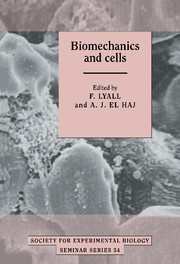Book contents
- Frontmatter
- Contents
- List of contributors
- PART 1 SOFT TISSUE
- Signal transduction pathways in vascular cells exposed to cyclic strain
- Effects of pressure overload on vascular smooth muscle cells
- Effect of increased flow on release of vasoactive substances from vascular endothelial cells
- Modulation of endothelium-derived relaxing factor activity by flow
- Stretch, overload and gene expression in muscle
- Stretch sensitivity in stretch receptor neurones
- Mechanical interactions with plant cells: a selective overview
- Mechanical tensing of cells and chromosome arrangement
- Alterations in gene expression induced by low-frequency, low-intensity electromagnetic fields
- PART 2 HARD TISSUE
- Index
Stretch, overload and gene expression in muscle
Published online by Cambridge University Press: 19 January 2010
- Frontmatter
- Contents
- List of contributors
- PART 1 SOFT TISSUE
- Signal transduction pathways in vascular cells exposed to cyclic strain
- Effects of pressure overload on vascular smooth muscle cells
- Effect of increased flow on release of vasoactive substances from vascular endothelial cells
- Modulation of endothelium-derived relaxing factor activity by flow
- Stretch, overload and gene expression in muscle
- Stretch sensitivity in stretch receptor neurones
- Mechanical interactions with plant cells: a selective overview
- Mechanical tensing of cells and chromosome arrangement
- Alterations in gene expression induced by low-frequency, low-intensity electromagnetic fields
- PART 2 HARD TISSUE
- Index
Summary
Skeletal muscle has considerable capacity to increase in mass, both during post-natal growth and even in the adult, to changed physical activity levels. For instance, during the rapid post-natal growth period, the male mouse is adding 25% new muscle per day (Goldspink & Griffin, 1973). In the adult rabbit, the tibialis anterior when subjected to stretch combined with electrical stimulation increases by 35% in mass within 4 days (Goldspink et al., 1992). This latter represents a synthetic rate of 30 000 myosin heavy chain (hc) molecules per nucleus per minute (Goldspink, 1985) which is remarkable but still only about one third of the synthetic capacity during the most rapid post-natal growth period.
As well as changes in muscle mass, changes in muscle phenotype often occur in response to physical signals (Gerlach et al., 1990; Goldspink et al., 1992). Mammalian skeletal muscles consist of populations of slow-contracting, oxidative fibres which are adapted for slow repetitive or postural type contractile activity, and fast-contracting fibres that are recruited for fast phasic movements. The muscle fibre types differ phenotypically in that they express different subsets of myofibrillar isoform genes as well as different types and levels of metabolic enzymes. The inherent ability of skeletal muscle to adapt to mechanical signals is related to its ability to switch on or switch off different isoform genes and to alter the general levels of expression of different subsets of genes.
- Type
- Chapter
- Information
- Biomechanics and Cells , pp. 81 - 95Publisher: Cambridge University PressPrint publication year: 1994



